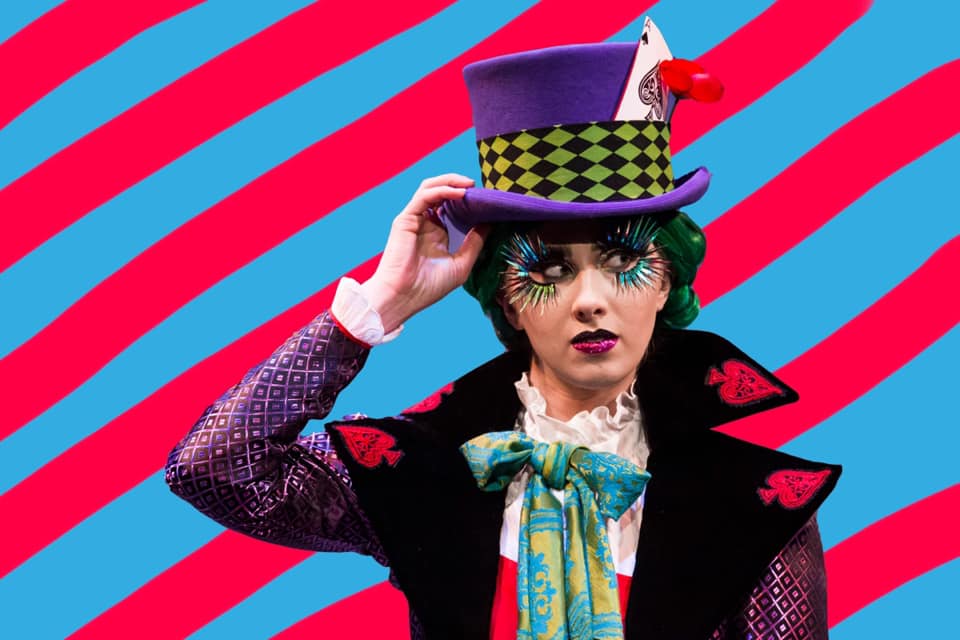PROVO — Alice Cornwickle’s life is falling apart. Her writing career lacks momentum and her marriage is falling apart at the seams. After a particularly taxing day, she comes home to her daughter, who reads her a bit of Lewis Carroll’s Jabberwocky. Though she falls asleep in the middle of the reading, her dreams continue to reflect the strange world built by Carroll, and she travels through the different oddities of Wonderland to find her daughter. As Alice progresses through the strange world, she comes to rediscover herself, her marriage, and find a spark of creativity once more.

The parts seemed greater than the whole in this particular show. I tried to make sense of a cohesive story line, but after the first half, I gave up trying to do so. Alice’s outside concerns provide a loose framework for Wonderland, but ultimately, feel less important than the stunning dream world. There’s some suggestion that the characters inside Wonderland might reflect people she’s encountered in her life, and that her adventure is pushing her to be more creative (and more forgiving to herself and husband), but again, Alice’s personal narrative felt far less important than Wonderland itself. There was absolute madness in the Wonderland world, and I would have been content to watch Alice stumble through without the framework of her real-life existence. Indeed, Carroll’s Wonderland that this show created for the stage straddles the line of grotesque and wonderful, creating a gritty and inviting dreamscape. Simply put, the story falls secondary to the spectacle here.
Technical construction in this production stood out. I enjoyed how psychedelic the whole experience felt—almost like a mix between a carnival and a rock concert. Each scene introduced a new musical style, and the lighting (designed by Marianne Ohran) shifted to reflect the nature of those styles. I particularly enjoyed the lighting during, “One Knight,” because it felt like a Backstreet Boys concert. Lighting again accurately reflected the important change when the Wonderland world shifted Through the Looking Glass, a dingier and dirtier version of the previous world, much more grotesque and foreboding. Set design (by Doug Ellis) remained simplistic, but I appreciated the absurdist touches. The main set piece, a large clock in the middle of the stage, moved backwards with shifts in time, and various doors appeared through which Alice would pass. The world the designers built was weird and unexpected, but wonderfully so.

Costumes (Erin Bjorn) and makeup (Brittany Troche) merit special laud for their work on this show. The world of Wonderland is a strange one, filled with anthropomorphic creatures and homages to various cultural groups. The designers’ work absolutely elevated the world’s content and created a visual spectacle that was both unsettling and gripping. Hatter’s first look, in particular, caught my attention: a combination of A Clockwork Orange and Victorian circus that was whimsical but creepy all at once. Modern touches to the various costumes brought an updated feel to the performance and suited the absurdist, anachronistic tone of the show. I liked the ‘New York hipster’ feel mentioned in the program. A cross-cut of the various cultural members of New York received representation and to great effect.
Similarly, choreography (Becky Wright Phillips and Shani Robison) featured an array of styles, each suited to the unique characters. Dances helped to elevate the manic Wonderland world into a whole new level of enjoyable weird. Movements felt fast, and there was always something interesting to watch. As one of my 6th grade students pointed out, the show paid homage to Fortnite dances. The little nods to audience members of all ages was endearing.

Performances were incredibly strong throughout the night. The students at BYU presented strong acting and vocal chops. Of note was Mackenzie Belnap as Mad Hatter. Belnap’s unmistakable presence on stage had just the right combination of creepy and compelling for the Mad Hatter character. The Mad Hatter was clearly the real power in Wonderland from the moment she stepped onstage. I also enjoyed Beatriz Melo as La Gata. With a little bit of chola flair, Melo commanded the stage with every step and exuded such a vibrant energy that it was hard not to enjoy every second she was onstage. Everyone had moments of brilliance, and it would be hard to list them all. Every single named character brought such enthusiasm and earnest flavor to their role. As Queen of Hearts, Nikole York might have been among my personal favorites of the night. Krista Saltmarsh as Alice brought a real level of maturity to her role, and with Jessica Sundwall’s voice behind her performance, maintained momentum and energy throughout her scenes. Additionally, the ensemble came together in easy cohesion and created a seamless performance that bolstered the show.
Frank Wildhorn, Gregory Boyd, and Jack Murphy have brought a strange dream world to the stage in Wonderland. While the surrounding story felt weak, moments inside Wonderland amazed and disturbed in the best of ways. I was constantly surprised by the shifting scenery and new interpretations of beloved characters. Prepare yourself for something a bit different than you might expect from BYU and venture down the rabbit hole. It’s worth a go!
[box]Brigham Young University’s production of Wonderland plays at the de Jong Concert Hall in the Franklin S. Harris Fine Arts Center (800 E. Campus Dr., Provo) on January 24-26 and January 29-February 2 at 7:30 PM and January 26 and February 2 at 2 PM with an ASL interpreted show on January 31. Tickets are $20-26. For more information, visit https://arts.byu.edu.[/box]
